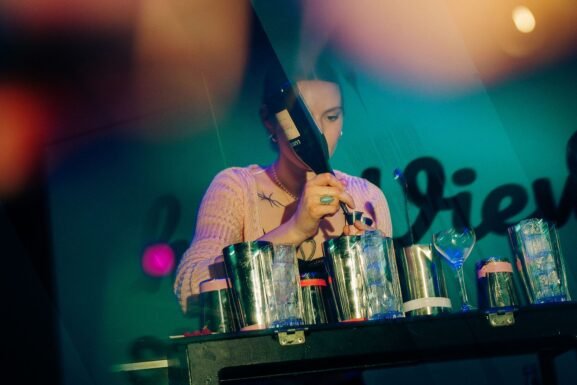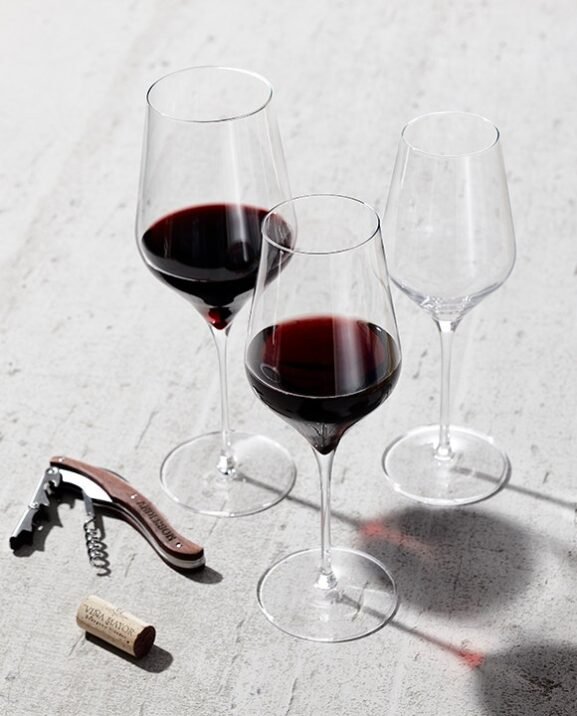Everything You Need to Know About Late Harvest Wine
While many of the acronyms and terms on wine labels can be challenging to decipher—think DOCG, AOP and Grosses Gewächs—late harvest is one of the more straightforward descriptors you’ll encounter at the bottle shop.
Simply put, the words “late harvest” indicate that the grapes used to produce a wine were left on the vine to continue to ripen beyond the typical vegetation cycle in that region in that particular year.
“In the 1700s, Spätlese [German for late harvest] was accidentally discovered in the Rheingau,” explains Michael Lykens, a portfolio manager at New York City-based importer and distributor Skurnik Wines & Spirits. “At this time, monks needed to wait for permission from the bishop to begin the harvest. Legend has it that there was a slow messenger, and the harvest was delayed by several weeks after botrytis had already spawned in the vineyard. The grapes that were brought to the press, already affected with noble rot, were made into a beautiful and rich wine with plenty of residual sugar, and thus, a new category of wine was created.”
Germany’s relatively cool climate made this style of wine both possible and necessary. To produce a good amount of wine, growers would leave grapes on the vine until very late in the year and harvest before the first frost.
Where Are Late Harvest Wines Produced?
In Germany, there are varying degrees of ripeness beyond late harvest: Auslese (selected harvest), Beerenauslese (berry selection) and Trockenberenausleese (dry berry selection).
“When I think of late harvest wines, my mind goes straight to Auslese Rieslings from Germany,” says Lina Goujjane, owner and wine director of Kiko in New York City. “Rieslings can offer intense acidity to offset the ripeness of the fruit from being picked later in the season. What you get in such a wine is ripe and spiced stone fruit balanced by a sharp citrus finish.”
But late harvest wines aren’t limited to Germany.
In Bordeaux, the Sauternes region produces acclaimed wines using Semillon, Sauvignon Blanc and Muscadelle. Northeastern Hungary is known for Tokaji Aszú, a prized dessert wine composed of Furmint, Hárslevelű and our other grape varieties. Eiswein (also known as Ice Wine) is often produced in Canada, Austria, Germany and the United States and is made with grapes that are left to freeze on the vine from December through late February, long after the traditional harvest period.
These sweet wines are also made in lesser-known regions, too. “There is a very special grape indigenous to Ankara, the capital of Turkey, that is often used in dessert wine called ‘Kalecik Karasi,’ as well as a grape called Bornova Misketi (100% Turkish Muscat) coming from Izmir, the city on the Aegean side of Turkey,” says Katrina Schult, owner and general manager of Hamdi, a Turkish restaurant in Seattle, Washington.
What Does a Late Harvest Wine Taste Like?
As wine ages, its aromas and flavors intensify.
“Expect a late harvest wine to have a deeper and more concentrated body,” says Lykens. “The fruit flavors of the wine will move from the realm of crunchy ‘fresh fruit’ and bright flavors to something riper and usually more oxidative.”
For example, ripe apples magically transform into candied apricots and peaches; with red wines, richer flavors and showcase some raisin or dehydrated flavors, while late harvest white wines lend themselves to honeyed and candied fruit flavors.
Elevated sugar content acts as a natural preservative, which is a core reason that late harvest wines are able to age terrifically.
“If the wine in question is made from a high acid grape, such as Riesling or Sauvignon Blanc, that can buy it an even longer lifespan,” adds Mackenzie Khosla, partner and wine director of Field Guide restaurant in Brooklyn. Lykens notes that despite their proclivity to aging, late harvest wines are also delicious in their youth, a time when they’re “bright, intense and pair wonderfully with less sweet desserts and cheeses,” he says. “You won’t regret sitting on an Auslese or Beerenauslese for 30-plus years. That’s why we always recommend buying a few bottles to experience its evolution.”
What’s the Difference Between Late Harvest and Noble Rot?
While many of the most famous late harvest wines (like Sauternes and Tokaji Aszu) are also impacted by noble rot, the two processes are unrelated in the vineyard. Noble rot refers to Botrytis cinerea, a beneficial fungus that can grow on grapes and dry them out while concentrating sugars; late harvest, on the other hand, refers to the time that the grapes are harvested.
“Botrytis very famously presents with saffron and honey aromas, which, when balanced, add terrific complexity and depth to the finished wines,” says Khosla. “While late harvest wines will generally give the honeyed, intense fruit presentation, the spice and complexity added by noble rot is truly the distinguishing factor.”
let adType_678180e992810 = “leaderboard”;
// Create the element
let script_678180e992810 = document.createElement(“script”);
script_678180e992810.innerHTML = `
window.googletag = window.googletag || {cmd: []};
googletag.cmd.push(function() {
var mapping;
// Size mapping for leaderboard ads
var lbmapping = googletag.sizeMapping()
.addSize([1024, 0], [[970, 250], [970, 90], [1, 1], [728, 90]])
.addSize([728, 0], [[728, 90], [1, 1]])
.addSize([320, 0], [[1, 1], [300, 50], [300, 100], [320, 50], [320, 100]])
.addSize([0, 0], [[1, 1], [320, 50]])
.build();
// Size mapping for med rectengle ads
var medrecmapping = googletag.sizeMapping()
.addSize([1024, 0], [[300, 600],[300, 250]])
.addSize([728, 0], [300, 250])
.addSize([320, 0], [[1, 1],[300, 250]])
.addSize([0, 0], [[1, 1], [300, 250]])
.build()
//var lbSlots = [[[320, 100], [728, 90], [300, 100], [1, 1], [300, 50], [970, 250], [320, 50], [970, 90]]];
//var medrecSlots = [[300, 600], [1, 1], [300, 250]];
mapping = adType_678180e992810 == ‘leaderboard’ ? lbmapping : medrecmapping;
googletag.defineSlot(‘/39808611/article_page/article_leaderboard_1’, [],
‘div-gpt-ad-678180e992810’).addService(googletag.pubads()).defineSizeMapping(mapping);
googletag.pubads().enableSingleRequest();
googletag.pubads().collapseEmptyDivs(); //maybe optional
googletag.pubads().refresh(); //maybe optional
googletag.enableServices();
});
`;
//checking to see if script is inserted in the header successfully
if (document.head.appendChild(script_678180e992810)) {
//variable holding the rendering body
document.getElementById(“gptBodySection-678180e992810”).innerHTML = `
googletag.cmd.push(function() { googletag.display(div-gpt-ad-678180e992810); });
`;
}
Why Are So Many Late Harvest Wines in Smaller Bottles?
Given the patience and delicate conditions needed to produce late harvest wines, it’s unsurprising that most are sold in bottles half the size of a standard wine bottle. This extra labor also translates into costs—a 375 ml bottle of Sauternes from cult-status producer Chateau d’Yquem, for example, can cost anywhere between $300 to $700.
“There’s a risk associated with late harvest and there’s a possibility that the grapes never fully ripen or get infected with less desirable strains of botrytis (there are dozens), and you’ve wasted a percentage of your harvest,” Lykens says. “These are, after all, products of nature, so there’s never a guarantee on what will happen next week. Many growers consider these a ‘labor of love’ as there’s very little money to be made with the production of late harvest wines, and you take what the vineyards give you.”
More Sweet Wine Coverage
- Your definitive guide to sweet wines.
- End the night on a sweet note with these excellent dessert wines.
- Vin Santo, the sweet ‘wine of saints,’ is poised for a revival.
- A guide to sparkling wine’s (often confusing) sweetness terms.
- Sweet, sparkling or dry: our top 10 Moscatos for every palate.
From the Shop
Find Your Wine a Home
Our selection of sweet wine glasses is the best way to enjoy the wine’s subtle aromas and bright flavors.
The post Everything You Need to Know About Late Harvest Wine appeared first on Wine Enthusiast.


